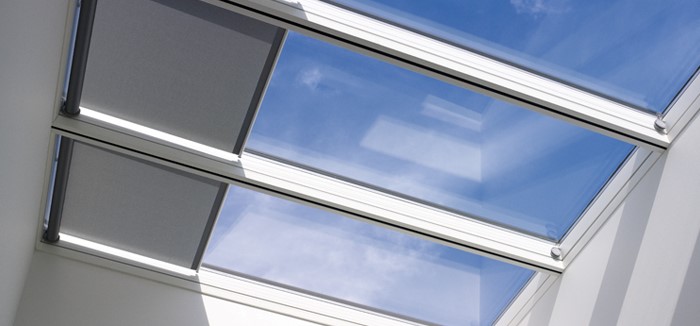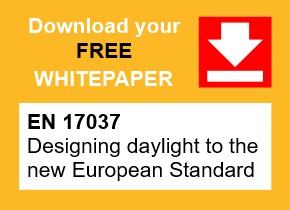Aspects of daylighting design covered by EN 17037
Contents |
[edit] Introduction
EN 17037 Daylight in buildings was published at the end of 2018 and is the first unified standard, applicable Europe-wide, that deals exclusively with the design for and provision of daylight within commercial buildings and residential dwellings.
It comprises four distinct areas:
- Daylight provision.
- Assessment of view out of windows.
- Access to sunlight.
- Prevention of glare.
Whilst designers may have familiarity with designing to provide daylight into commercial buildings, the other three aspects of EN 17037 significantly extend the scope of daylight design. This article presents an overview of all four areas that EN 17037 covers.
[edit] Daylight provision
Adequate daylight provision allows users to carry out tasks and plays a part in determining the likelihood for the need of artificial lighting at certain times of the day. Climate-based modelling or daylight factor calculations can be used for the assessment of daylight provision within buildings.
[edit] Assessment of view out of windows
EN 17037 considers the width and outside distance of the view, as well as landscape ‘layers’ (sky, landscape and ground) that a window offers building users. The overall view to be provided should be clear, undistorted and neutrally coloured. The width of view can be determined via either a detailed or simplified approach. The outside distance and number of layers, however, are each measured by a single approach.
[edit] Access to sunlight
Calculating the access, or exposure, to sunlight is a health and comfort factor for users of residences, nurseries and hospital wards. The daily sunlight exposure can be determined through detailed calculations or via table values.
[edit] Prevention of glare
Prevention of glare is concerned with eliminating the chances of glare for building users. This is especially important for those who do not choose where they sit within their environment. It is determined using a comprehensive daylight glare probability (DGP) calculation or using a standard table of values for sun-screening materials.
[edit] How the provision of daylighting design is measured
To offer flexibility for designers and architects whilst also making the standard useable and understandable, EN 17037 sets a mandatory minimum level of performance for each of the four areas of daylighting design.
The standard also gives two additional performance levels: medium and high. Users of EN 17037 are free to select the performance level that best suits the building design and proposed building’s utilisation. Both a simplified and detailed method is offered to assess each design area.
Visit the VELUX Commercial website for further guidance on EN 17037.
See also:
VELUX Commercial specialise in offering a range of daylight solutions for any commercial building project. Contact us for more information or to find out how our rooflights can improve daylighting on your next development.
[edit] Related articles on Designing Buildings Wiki
- Artificial lighting.
- Daylight.
- Daylight factor.
- Daylit space.
- Designing daylight solutions for commercial buildings.
- EN 17037 Daylight in buildings.
- Glare.
- Health and wellbeing impacts of natural and artificial lighting.
- Lighting.
- Lighting and health infographic.
- Lighting designer.
- Lighting and offices.
- Rooflights.
- Site layout planning for daylight and sunlight.
- Solar gain.
- Types of building EN 17037 applies to.
- Types of lighting.
- Windows.
Featured articles and news
The UK's Modern Industrial Strategy: A 10 year plan
Previous consultation criticism, current key elements and general support with some persisting reservations.
Building Safety Regulator reforms
New roles, new staff and a new fast track service pave the way for a single construction regulator.
Architectural Technologist CPDs and Communications
CIAT CPD… and how you can do it!
Cooling centres and cool spaces
Managing extreme heat in cities by directing the public to places for heat stress relief and water sources.
Winter gardens: A brief history and warm variations
Extending the season with glass in different forms and terms.
Restoring Great Yarmouth's Winter Gardens
Transforming one of the least sustainable constructions imaginable.
Construction Skills Mission Board launch sector drive
Newly formed government and industry collaboration set strategy for recruiting an additional 100,000 construction workers a year.
New Architects Code comes into effect in September 2025
ARB Architects Code of Conduct and Practice available with ongoing consultation regarding guidance.
Welsh Skills Body (Medr) launches ambitious plan
The new skills body brings together funding and regulation of tertiary education and research for the devolved nation.
Paul Gandy FCIOB announced as next CIOB President
Former Tilbury Douglas CEO takes helm.
UK Infrastructure: A 10 Year Strategy. In brief with reactions
With the National Infrastructure and Service Transformation Authority (NISTA).
Ebenezer Howard: inventor of the garden city. Book review.
The Grenfell Tower fire, eight years on
A time to pause and reflect as Dubai tower block fire reported just before anniversary.
Airtightness Topic Guide BSRIA TG 27/2025
Explaining the basics of airtightness, what it is, why it's important, when it's required and how it's carried out.
Construction contract awards hit lowest point of 2025
Plummeting for second consecutive month, intensifying concerns for housing and infrastructure goals.
Understanding Mental Health in the Built Environment 2025
Examining the state of mental health in construction, shedding light on levels of stress, anxiety and depression.
The benefits of engaging with insulation manufacturers
When considering ground floor constructions.
Lighting Industry endorses Blueprint for Electrification
The Lighting Industry Association fully supports the ECA Blueprint as a timely, urgent call to action.


























